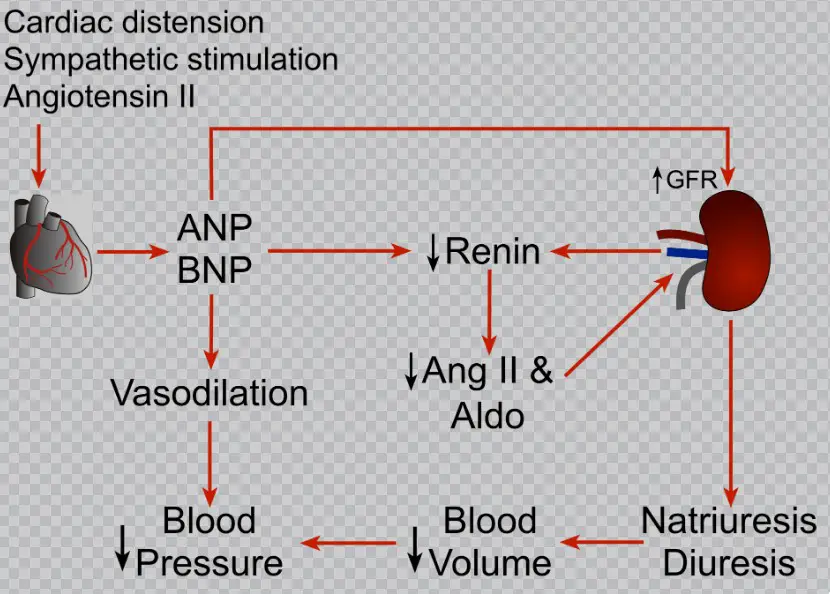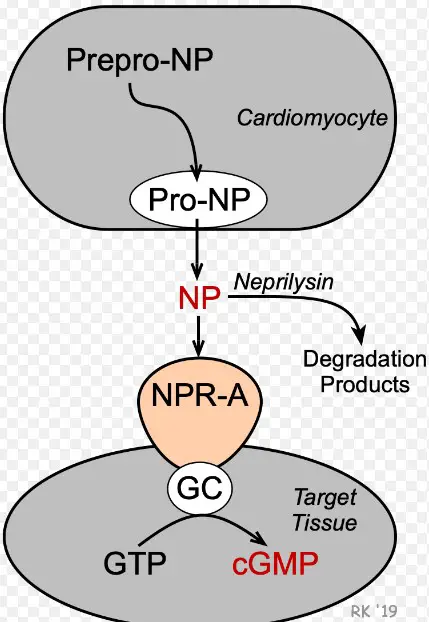Atrial Natriuretic Peptide (ANP) and Brain Natriuretic Peptide (BNP) are two critical components of the heart’s response to cardiovascular stress and fluid homeostasis. These peptides play essential roles in regulating blood pressure and volume, indicating their importance in diagnosing and managing heart conditions. Despite their shared objectives, ANP and BNP originate from different parts of the heart and serve unique purposes, reflecting in their diagnostic and therapeutic applications.
ANP is produced by the atrial chambers of the heart, mainly in response to an increase in blood pressure, aiming to reduce the workload on the heart by decreasing blood volume and pressure. On the other hand, BNP is produced in the ventricles and is closely associated with ventricular pressure and heart failure, serving as a key marker for diagnosing heart conditions. Understanding the difference between ANP and BNP is crucial for accurate diagnosis and effective treatment of cardiovascular diseases.
These peptides not only illuminate the body’s intricate response to heart stress but also guide medical professionals in tailoring treatments for heart disease. The distinction between ANP and BNP lies in their production, role, and impact on heart function, offering a window into the body’s mechanisms for maintaining cardiovascular health and signaling when intervention is necessary.

Basics of Hormones
Hormones are chemical messengers that play a crucial role in the body’s internal communication system. They are produced in one part of the body and travel to other parts to deliver messages that tell organs and tissues what to do. Two such hormones, Atrial Natriuretic Peptide (ANP) and Brain Natriuretic Peptide (BNP), are vital in the cardiovascular system, managing blood pressure and volume.
ANP Overview
Definition and Production
ANP is a hormone secreted by the atrial cells of the heart when they are stretched due to increased blood volume. This peptide hormone consists of amino acids and plays a significant role in reducing blood pressure and controlling fluid balance.
Role in the Body
ANP operates by causing the dilation of blood vessels and promoting the excretion of sodium and water by the kidneys. This action effectively decreases blood volume and pressure, aiding in the regulation of the body’s fluid balance and reducing the heart’s workload.
BNP Overview
Definition and Production
BNP, similar to ANP, is a peptide hormone but is primarily released from the ventricles of the heart. Its production is stimulated by conditions that exert pressure on the ventricles, such as heart failure.
Role in the Body
The role of BNP is closely aligned with heart health. It works by relaxing blood vessels and increasing the elimination of sodium and water, similar to ANP. However, its strong association with ventricular pressure makes it a key marker for heart failure and ventricular dysfunction.
Production Sites
The heart plays a pivotal role in the production of ANP and BNP, with specific chambers responsible for their release.
Heart’s Role
ANP: Atria
ANP is synthesized and released by the atrial chambers when they stretch due to increased blood volume. This mechanism ensures the body can quickly respond to changes in blood volume and pressure.
BNP: Ventricles
In contrast, BNP is produced in the ventricles under conditions of excessive stretching and stress, typically due to heart failure or ventricular dysfunction.
Biological Triggers
Several conditions can trigger the release of ANP and BNP, primarily related to changes in heart function and blood volume.
Conditions Leading to ANP and BNP Release
- Increased blood volume: Elevates heart pressure, stretching the atrial or ventricular walls.
- Heart failure: Specifically triggers BNP due to ventricular stress.
- Hypertension: Can prompt the release of ANP as the body attempts to lower blood pressure.
Key Functions
ANP and BNP have critical functions in maintaining cardiovascular health, especially in regulating blood pressure and fluid balance.
ANP Functions
Blood Pressure Regulation
ANP helps to reduce blood pressure by dilating blood vessels and decreasing blood volume, which in turn reduces the strain on the heart.
Sodium and Water Balance
It promotes the excretion of sodium and water, which directly influences blood volume and pressure, aiding in fluid balance and preventing fluid overload.
BNP Functions
Response to Ventricular Expansion
BNP is released in response to ventricular expansion, signaling the need to reduce blood volume and pressure to alleviate stress on the heart.
Indicator of Heart Failure
Due to its production in response to ventricular stress, BNP serves as a critical biomarker for diagnosing heart failure, offering insights into heart health and functioning.
Molecular Structure
Understanding the molecular structure of ANP and BNP provides insight into their functions and how they interact within the body to exert their effects on cardiovascular health.
ANP Structure
Amino Acid Composition
ANP is a peptide hormone composed of 28 amino acids. This structure is crucial for its ability to bind to specific receptors on cells and initiate the biological processes that lead to the excretion of sodium and the reduction of blood volume and pressure.
Receptor Interactions
ANP primarily interacts with the natriuretic peptide receptor A (NPR-A), which is found in various tissues, including kidney, adrenal glands, and blood vessels. This interaction triggers a cascade of events leading to vasodilation and diuresis, effectively reducing blood pressure and blood volume.
BNP Structure
Amino Acid Composition
BNP consists of 32 amino acids, making it slightly larger than ANP. This difference in amino acid composition affects its half-life and receptor affinity, which is key to its role in managing cardiovascular stress and heart failure.
Receptor Interactions
Similar to ANP, BNP binds to NPR-A but has a longer half-life, allowing it to exert its effects for a more extended period. This binding results in similar vasodilatory and diuretic effects, crucial for managing conditions like heart failure.
Clinical Significance
The clinical significance of ANP and BNP extends beyond their physiological roles, playing a pivotal part in the diagnosis and management of heart diseases.
Diagnostic Use
ANP and BNP in Heart Disease Diagnosis
Both ANP and BNP levels are used in the clinical setting to diagnose heart conditions, especially heart failure. Elevated levels of BNP are particularly indicative of heart failure, given its release in response to ventricular stretch and stress.
Predictive Value
Prognostic Implications in Heart Conditions
High levels of ANP and BNP are associated with an increased risk of cardiovascular events and mortality in patients with heart failure. Monitoring these levels can provide valuable prognostic information, guiding treatment decisions and patient management.
Testing and Measurement
Accurate measurement of ANP and BNP levels is crucial for diagnosing heart conditions and assessing treatment efficacy.
Laboratory Tests
Methods for Measuring ANP and BNP Levels
- Blood tests: The most common method for measuring ANP and BNP levels, involving drawing blood from a vein.
- Immunoassays: Specific tests that use antibodies to detect and measure the levels of ANP and BNP in the blood.
Interpretation of Results
Normal vs. Elevated Levels
- Normal levels of ANP and BNP vary depending on age, sex, and assay used, but generally, levels above the normal range indicate heart stress or failure.
- Elevated levels suggest cardiovascular stress, with higher levels correlating with increased severity of heart conditions.
Factors Affecting Interpretation
- Renal function: Can influence the clearance of these peptides, affecting their blood levels.
- Obesity: May lower BNP levels, complicating the diagnosis of heart failure in obese patients.
Treatment Implications
The understanding of ANP and BNP has significant implications for the treatment of heart conditions, guiding therapy and future research into novel treatments.
ANP and BNP in Treatment
Role in Managing Heart Conditions
The measurement of ANP and BNP levels assists in diagnosing heart conditions, monitoring treatment efficacy, and guiding therapeutic decisions, such as the need for diuretics or other medications to manage blood volume and pressure.
Future Therapeutics
Research on ANP and BNP Based Treatments
- Natriuretic peptide receptor agonists: Drugs that mimic the action of ANP and BNP by binding to their receptors, offering potential new treatments for heart failure and hypertension.
- Gene therapy: Research into gene therapy aims to increase the production of ANP and BNP in patients with heart failure, offering a novel approach to treatment.
FAQs
What triggers ANP and BNP release?
The primary trigger for ANP release is the stretching of the heart’s atrial walls due to increased blood volume, leading to a reduction in blood volume and pressure as a response. BNP is similarly released in response to stretching, but in the ventricles, often indicating heart failure or conditions that increase the pressure on the heart.
How are ANP and BNP levels measured?
ANP and BNP levels are measured through blood tests. These tests are crucial in diagnosing and monitoring heart failure and other cardiovascular diseases, as elevated levels of these peptides can indicate heart stress or damage.
Can ANP and BNP levels predict heart disease?
Yes, elevated levels of ANP and BNP are strong predictors of heart disease, especially heart failure. They can provide crucial information about the heart’s function and the severity of the condition, aiding in early diagnosis and the management of treatment strategies.
What is the difference between ANP and BNP in heart failure?
While both ANP and BNP levels rise in response to heart failure, BNP levels are more specifically associated with ventricular strain and are more widely used in diagnosing and monitoring heart failure. ANP, while also elevated, serves a broader role in reducing blood volume and pressure.
Conclusion
The nuanced differences between Atrial Natriuretic Peptide (ANP) and Brain Natriuretic Peptide (BNP) underline their significance in cardiovascular health and disease management. By distinguishing between these peptides, medical professionals can make informed decisions, leading to more precise diagnoses and tailored treatments for patients with heart conditions.
Understanding ANP and BNP not only sheds light on the body’s complex response to cardiac stress but also paves the way for innovative treatments and diagnostic tools. As research continues to unravel the intricate roles of these peptides, their importance in the landscape of cardiovascular care remains undeniable, offering hope for improved outcomes in heart disease management.

